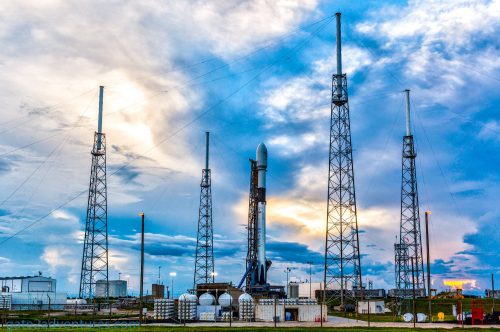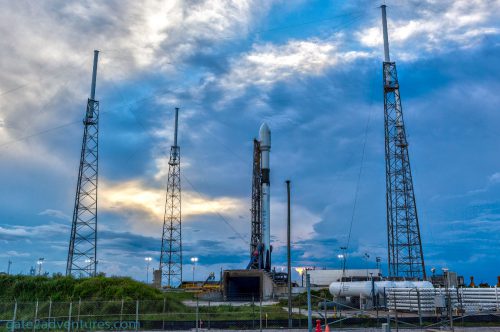 SpaceX did it again and had a successful rocket launch this past weekend. So why covering rocket launches here so much? First of all, I just love rockets. To see a rocket launch live and in person is something special no live webcast can give you. The live-feed might have some better videos, but hearing and feeling the 9 Merlin rocket engines propelling the Falcon 9 rocket and its payload into space is something special. Over and over again. I watched my first ever rocket launch in Cape Canaveral and it was a Falcon9 carrying out a resupply mission (CRS13) to the International Space Station (ISS). Since that moment, I was hooked.
SpaceX did it again and had a successful rocket launch this past weekend. So why covering rocket launches here so much? First of all, I just love rockets. To see a rocket launch live and in person is something special no live webcast can give you. The live-feed might have some better videos, but hearing and feeling the 9 Merlin rocket engines propelling the Falcon 9 rocket and its payload into space is something special. Over and over again. I watched my first ever rocket launch in Cape Canaveral and it was a Falcon9 carrying out a resupply mission (CRS13) to the International Space Station (ISS). Since that moment, I was hooked.
Rocket launches became a new “tourist attraction” and will continue to impress. Many people travel to Cape Canaveral or other launch sites to witness rocket launches live. Besides watching rocket launches, I also love the challenge of taking photos of the launch. This past weekend launch was no exception.
After a few weeks of delay, the launch date was finally set. In my case, I didn’t have to travel very far, as I was in Miami during the week and drove up to “The Cape” to watch another launch live.
Launch Pad Visit
Launch time was scheduled to be at 11:23 p.m. on Sunday (September 9, 2018) with a four-hour launch window. During the evening hours and just before sunset I was able to join a group of media to visit the rocket live out on the pad at SLC-40. Most of the people set up remote cameras to have close-up photos of the rocket during launch. This is one of my next photography-challenges I want to master. During the time out there on the pad, I got some of the best pictures ever of a Falcon 9. This was my first time to get that close to a rocket ready for launch. A big thanks again to SpaceX for this amazing opportunity to go out there with you guys.
Pre-Launch
After leaving the pad, I went back to my nearby hotel in Cocoa Beach and double checked my gear. Shortly after 9 p.m., I headed back over to the Cape to set up my camera along the ITL causeway from where I was watching the launch. Other media outlets were out here as well to cover the launch.
During the evening hours, heavy thunderstorms and lightning were all around “The Cape”. A level 2 lightning warning was issued for Cape Canaveral and the launch got pushed back a few times to let the weather clear up. New launch time was now 12:45 a.m. EDT on Monday, September 10th, 2018.
“During the liquid oxygen loading, we could hear the hissing and popping of pressure from the rocket and see the moist Florida atmosphere condensing around the areas where the cold gaseous oxygen is vented overboard and at the bottom of the rocket where liquid oxygen is used to chill in the Merlin Turbopumps” – John Insprucker (Falcon Principal Integration Engineer and Webcast Host) explains.
Launch
The countdown continued without a hold and the Falcon lifted off from SLC-40 as planned at 12:45 EDT. First, we saw the rocket engines lighting up the night and a few seconds later we could hear the 9 Merlin engines while lifting the rocket and it’s payload to a Geostationary-Transfer-Orbit (GTO).
After Falcon 9 left the pad and soared through the night sky, only the stream of fire spit out by the 9 mighty Merlin engines was visible. As with most night-launches, this is everything you get to see once the rocket is further up in the sky.
I tried myself on another video of the launch. Unfortunately, I have no telephoto lens for the video camera I used to film the launch. I need to upgrade to a better and more directional microphone to avoid the cracks in the sound playback. However, you still get to hear the 9 Merlin engines pretty well as the rocket soars through the sky. During the official webcast, which I embedded at the bottom of the post, you couldn’t hear the engines that well.
Telstar 18 Vantage Payload
For all of you interested in what the rocket was carrying into space. Read SpaceX’s official press release.
Telstar 18 VANTAGE is the third high throughput satellite (HTS) in Telesat’s global fleet and the first with coverage over the Asia Pacific region. Its innovative payloads will provide Telesat’s customers with a new level of performance and value to serve growing satellite broadband requirements on land, at sea, and air. Built by SSL, a Maxar Technologies Company, Telstar 18 VANTAGE will replace and expand on the capabilities of Telesat’s Telstar 18 satellite through its extensive C-band capacity over Asia, its Ku-band HTS spots over Indonesia and Malaysia, and its five additional Ku-band beams. Located at 138 degrees East, the coverage of Telesat’s newest satellite reaches across Asia all the way to Hawaii – in both C and Ku-bands – enabling direct connectivity between any point in Asia and the Americas. Its Ku-band payloads of HTS spot beams and focused regional beams will provide customers operating in Southeast Asia, Mongolia, Australia & New Zealand, and the North Pacific Ocean with greater choice and flexibility to serve today’s bandwidth intensive applications.
Telesat VANTAGE satellites combine focused regional beams with powerful HTS spot beams enabling users to maximize throughput and spectral efficiency while optimizing network performance. By implementing these advances on Telstar 18 VANTAGE, Telesat customers across the Asia Pacific region will have a competitive edge in meeting the growing demand for satellite broadband from mobility markets – both aero and maritime, enterprise network operators and from leading telecom companies.
Telstar 18 VANTAGE is expected to enter commercial service this fall after it has completed orbit raising and on-orbit testing. The satellite has a 15-year design life.
Post Launch
This was SpaceX’s 60th successful Falcon 9 mission by successfully deploying the payload to GTO. About 2.40 minutes into the flight Stage 1 separated from Stage 2. Stage 1 started its coast down towards the drone ship “Of Course I Still Love You (OCISLY)”. After a successful Entry Burn and Landing Burn, the first stage landed safely on the drone ship stationed in the Atlantic Ocean at about T+ 8:40. After just over 32 minutes into the flight, SpaceX successfully deployed the Telstar satellite into GTO.
Official Webcast SpaceX Telstar 18 Vantage Launch
More photos of the launch…

Peter has a passion for Traveling, Photography, and Geocaching. These are the best ingredients for amazing adventures all over the globe. “Traveling is fun, no matter if you stay in a luxury hotel or travel like a backpacker.” Peter shares his experiences on his Blog www.gatetoadventures.com
Some of Peter’s photos are published on corporate websites, in-flight magazines, travel guides, and much more.
















